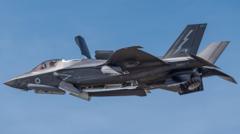Are Delays and Shortages Plaguing the UK's F-35 Jet Fleet?

Assessing the Challenges of the UK's F-35 Warplane Programme
The United Kingdom's investment in the F-35 stealth jet programme represents a significant commitment to enhancing its military capabilities. However, a recent report by the National Audit Office (NAO) has unveiled a range of challenges that threaten the effectiveness of this programme. Delays, infrastructure gaps, and personnel shortages are among the key issues that the NAO highlights, revealing that the UK's warfighting capability is being undermined. Despite the F-35's advanced technology and superiority over previous UK aircraft, the outcomes of the programme have not met expectations, raising questions about the future of Britain's military readiness. This article will delve into the intricacies of the F-35 programme, the challenges it faces, and the broader implications for the UK's national security strategy.
The Promise of the F-35 Stealth Jet
At the heart of the UK's military modernization efforts is the F-35 stealth jet, manufactured by Lockheed Martin. The F-35 is a fifth-generation multi-role fighter that boasts advanced stealth capabilities, sensor fusion, and an array of cutting-edge technologies. Its introduction into the Royal Air Force (RAF) and Royal Navy represents a significant leap forward in air combat capabilities.
Key Features of the F-35
- Stealth Technology: The F-35's design minimizes its radar cross-section, making it difficult for enemy radars to detect and track.
- Advanced Avionics: Equipped with state-of-the-art sensors, the F-35 can gather and process vast amounts of data, providing pilots with enhanced situational awareness.
- Versatile Combat Roles: The F-35 can perform various missions, including air-to-air combat, ground attack, and intelligence, surveillance, and reconnaissance (ISR) operations.
- Interoperability: The F-35 is designed to work seamlessly with allied forces, making it a crucial asset in joint operations.
As of June 2025, the RAF has 37 F-35s in service, deployed from the Royal Navy's two aircraft carriers. These aircraft are expected to remain operational until 2069, providing the UK with long-term capabilities in air defense and strike operations.
The Financial Landscape of the F-35 Programme
Despite the advanced capabilities of the F-35, the financial oversight of the programme has raised concerns. The NAO's report indicates a significant disparity between initial budget forecasts and actual expenditures.
Budget Overruns and Cost Estimates
Initially, the Ministry of Defence (MoD) estimated the total cost of the F-35 programme at £18.76 billion. However, the NAO's assessment has placed the projected costs at a staggering £71 billion. This sharp increase in spending has led to questions regarding the management and oversight of the programme.
Disappointing Returns on Investment
The NAO has characterized the return on the £11 billion already spent as "disappointing." The report highlights that the full mission capable rate of the F-35 fleet was only around one-third of the MoD’s target. This statistic indicates that while the technology is advanced, the operational effectiveness of the fleet is not meeting expectations.
Challenges Faced by the F-35 Programme
The NAO's report underscores several critical challenges that have emerged in the F-35 programme, hindering its potential and effectiveness.
Delays in Weapon Integration
One of the significant setbacks has been the delay in equipping the F-35 with advanced weaponry capable of engaging ground targets while maintaining stealth characteristics. The integration of these weapons systems is now pushed back to the early 2030s, which significantly impacts the aircraft’s operational readiness and versatility.
Infrastructure Gaps
Another challenge lies in the existing infrastructure, which has been deemed inadequate for supporting the operational needs of the F-35 fleet. Modernizing facilities and ensuring that maintenance and logistics can keep pace with the operational demands of the aircraft is crucial for maximizing its potential.
Personnel Shortages
The shortage of skilled personnel trained to operate and maintain the F-35s is an additional hurdle. As the complexity of modern fighter jets increases, so does the need for a highly skilled workforce. The MoD must prioritize recruitment and training to ensure that there are enough qualified personnel to support the F-35 operations effectively.
Strategic Implications for the UK's National Security
The challenges facing the F-35 programme have broader implications for the UK's national security strategy. As global threats evolve, the need for a capable and ready military force becomes increasingly critical.
Alignment with NATO Goals
Prime Minister Sir Keir Starmer has emphasized the importance of increasing UK defense spending to 5% of GDP by 2035. This commitment aligns with NATO's strategic goals in response to perceived threats, particularly from Russia. However, the effectiveness of this increased funding will depend on how well the MoD addresses the challenges highlighted by the NAO.
Economic Benefits of the F-35 Programme
Despite the setbacks, the F-35 programme has generated economic benefits for the UK. The MoD spokesperson highlighted that the programme has created £22 billion worth of work for UK companies, supporting thousands of jobs. The continued investment in the F-35 will be crucial for sustaining these economic advantages while enhancing military capabilities.
Future Outlook for the F-35 Programme
Looking ahead, the UK's F-35 programme faces a pivotal moment. The MoD must reassess its priorities and resource allocation to ensure that the full potential of the F-35 can be realized.
Prioritization of Resources
Gareth Davies, head of the NAO, has called on the MoD to prioritize resources effectively. This involves not just financial investment but also strategic planning that addresses the challenges of infrastructure and personnel shortages. Ensuring that the F-35s are fully operational and capable of meeting the UK's defense needs will require a concerted effort across multiple fronts.
Commitment to Innovation
Innovation in military technology is essential for maintaining a competitive edge. As the F-35 programme progresses, continued investment in research and development will be necessary to keep pace with advancements in military aviation and ensure that the UK remains a formidable force on the global stage.
Conclusion
The F-35 stealth jet programme represents both an opportunity and a challenge for the UK's defense strategy. While the advanced capabilities of the F-35 are undeniable, the issues of budget overruns, delays, and personnel shortages must be addressed to maximize its effectiveness. As the UK navigates an increasingly complex security landscape, the success of the F-35 programme will be pivotal in shaping the future of its military capabilities. With strategic focus and resource allocation, the UK can harness the full potential of the F-35 and enhance its warfighting capabilities for years to come.
FAQs
What are the main challenges facing the UK's F-35 programme?
The main challenges include delays in weapon integration, infrastructure gaps, and personnel shortages that impact the operational readiness of the F-35 fleet.
How much has the UK spent on the F-35 programme to date?
As of now, the UK has spent approximately £11 billion on the F-35 programme, which is higher than initial estimates.
What is the expected lifespan of the F-35 aircraft?
The F-35 aircraft are expected to remain in service until 2069, providing long-term capabilities for the UK military.
How does the UK's F-35 programme align with NATO goals?
The UK’s investment in the F-35 programme aligns with NATO's goal of increasing defense spending to address evolving security threats, particularly from Russia.
What economic benefits does the F-35 programme provide to the UK?
The F-35 programme has generated approximately £22 billion worth of work for UK companies and created thousands of jobs, contributing to the economy.
As the UK moves forward with its military modernization efforts, how do you think the challenges of the F-35 programme will influence its overall defense strategy? #F35 #UKDefense #MilitaryModernization
Published: 2025-07-11 03:49:15 | Category: technology



